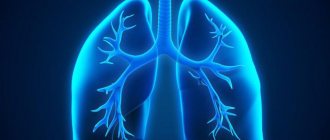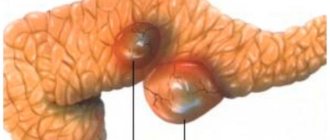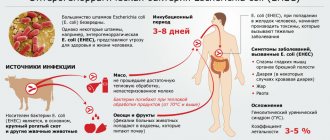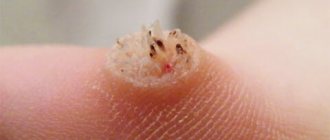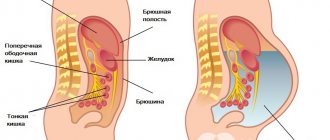05/10/2018 Olga Migunova 0 comments
Inflammation of the bronchi is a common occurrence in childhood. Simple forms of the disease, if the treatment regimen prescribed by the doctor is followed, can be successfully treated at home. But this does not apply to a type of illness such as obstructive bronchitis in children, since most children with a similar diagnosis require hospitalization.
The parents’ task is to pay attention to signs of obstruction in time and call a doctor. With obstructive bronchitis, the risk of developing serious complications is quite high, and only timely therapy helps to avoid life-threatening consequences of the disease.
What is obstructive bronchitis in children?
The term “obstructive bronchitis” in medicine refers to inflammation of all elements of the bronchial tree, occurring with a violation of the normal patency of the bronchi (obstruction). As a result, it becomes difficult for the mucus produced to clear, which in turn is associated with the following changes:
- the bronchial muscles spasm, and, as a result, the lumen of the bronchial tree narrows;
- The viscosity of sputum increases, it becomes dense and difficult to separate. At the same time, more mucus begins to be produced;
- swelling of the mucous membranes increases, which further narrows the airways.
The frequent development of obstructive bronchitis in preschool age is associated with the anatomical and physiological characteristics of the respiratory system, with the imperfection of the immune system and with the special functioning of the bronchi.
Obstructive bronchitis in children most often occurs in the first three years of their life. According to statistics, at this age more than 20% of children suffer from bronchitis with obstructive symptoms. The risk group includes children and preschoolers who frequently suffer from respiratory infections (more than 6 times a year) with a history of allergic diseases. In most cases, obstructive bronchitis occurs during the cold months of the year.
Recurrent forms of obstructive bronchitis increases the likelihood of developing bronchial asthma, bronchiolitis obliterans, emphysema, and chronic bronchitis.
Classification
There are several forms of obstructive bronchitis, which are often diagnosed in childhood:
- Acute obstructive bronchitis. This form of pathology develops against the background of a viral infection that has penetrated the child’s body. The first signs become noticeable a few days after the onset of ARVI or influenza. Acute obstructive bronchitis in young children is accompanied by a debilitating cough with wheezing and breathing difficulties.
- Chronic or recurrent bronchitis. Most often, this form of pathology is a consequence of poorly treated acute bronchitis. Characteristic manifestations are coughing attacks in the morning, increased sweating, a slight rise in body temperature and fatigue. Chronic obstructive bronchitis can worsen in a child several times a year due to severe hypothermia.
- Allergic obstructive bronchitis. This form of pathology is paroxysmal in nature and develops when the body comes into close contact with an allergen. Signs of such obstructive bronchitis in children are rhinitis and increased lacrimation, but the body temperature does not increase.
Any type of obstructive bronchitis poses a serious danger to a small child, especially if it is severe.
It is necessary to begin treatment immediately after diagnosis, which will avoid the development of many complications.
Main causes of the disease
In more than half of cases, the cause of obstructive bronchitis under the age of three years is infection of the respiratory system by viruses. Most often this is:
- influenza and parainfluenza viruses;
- enterovirus;
- adenoviruses;
- respiratory syncytial viral microorganism.
Among the bacterial pathogens of the disease are Streptococcus pneumoniae and Haemophilus influenza. Moraxella catarrhalis. Obstruction can develop against the background of viral-bacterial infection; if recurrent forms of pathology are detected, it is necessary to exclude the presence of mycoplasmas, chlamydia, cytomegalovirus, and herpes infection in the body. Most often, the first signs of bronchial obstruction in young children appear against the background of ARVI.
There are several provoking factors of the disease that explain the frequent occurrence of obstruction in childhood, these are:
- features of the structure and functions of the respiratory system: narrowness of the lumen of all respiratory tracts;
- insufficient functioning of local immunity organs;
- insufficient elasticity of the bronchial tree frame;
- weakness of the muscles of the respiratory system;
- increased viscosity of mucus produced;
- in young children - predominance of sleep over the active period, prolonged stay in a supine position, which worsens the drainage properties of the bronchi;
The development of obstructive bronchitis is also influenced by the unfavorable conditions in which the child lives. These are high humidity in living spaces, fungus on the walls, smoking of parents in the presence of children, poor environmental conditions in the area of residence.
The likelihood of developing a disease is increased if the child does not receive enough essential vitamins and microelements along with food.
How to recognize the disease
A pediatrician can establish an accurate diagnosis by listening to the child, examining him, interviewing the mother, and test results. The age of the baby and the changes occurring with the child at this stage of development must be taken into account.
Parents of newborns often sound the alarm in vain. They forget about the physiological characteristics of the baby and confuse serious illnesses with a common cold or a negative reaction to errors in care. When making a diagnosis, you need to understand the following:
- Bronchitis is very rare in newborns and 3-month-old children. Their innate immunity saves them from disease. An infant coughs due to dry air, smoke in the apartment, if dad smokes. Proper care and an optimal microclimate in the nursery will help correct the situation, the baby will stop coughing and choking.
- Children aged five to six months begin to erupt their first teeth. Cough is provoked by the active work of the salivary gland. The baby does not have time to swallow saliva, so he coughs. Sputum comes out easily, there is no difficulty breathing. Temperature and moodiness also appear as a reaction to teeth. Contact your doctor. After listening to the baby's chest, the diagnosis can be made accurately.
- The next age stage - from 6 to 12 months - is the most dangerous.
Innate immunity is depleted. The likelihood of bacterial and viral bronchitis increases. Fever, suffocating cough, and expectoration of green sputum indicate precisely this illness. The doctor will hear wheezing in the chest and prescribe a blood, urine, and mucus test to determine the cause of the disease.
On a note! A general blood test will indicate infection or inflammation if ESR and lymphocyte levels are elevated. X-rays help distinguish prolonged bronchitis from pneumonia.
Pathogenesis
Bronchial obstruction develops according to a specific mechanism.
- The pathogenic microorganism penetrates the mucous membranes of the bronchi, which leads to the appearance of a local inflammatory reaction.
- Under the influence of viruses or bacteria, the immune system begins to produce large quantities of interleukin-1, a mediator of inflammation. In turn, under its influence, the permeability of the vascular walls increases, the mucous membranes swell, and microcirculation in the bronchi is disrupted.
- The secretion of mucus increases, and its rheological properties change, that is, it becomes viscous and less fluid.
- The drainage function of the bronchial tree deteriorates, this leads to the accumulation of sputum, resulting in the creation of ideal conditions for the further development and reproduction of the pathogenic microorganism.
- The reactivity of the bronchi increases, bronchospasm occurs.
All changes that accompany the development of bronchial obstruction reduce breathing efficiency and lead to insufficient oxygen supply to most tissues and internal organs.
Clinical picture of obstructive bronchitis
At the initial stage, the disease can only manifest itself as a sore and sore throat, fever, and rhinorrhea. The child may be anxious, often refuses to eat, and dyspepsia cannot be ruled out at an early age.
Signs of bronchial obstruction usually appear within 1-2 days. Pathology can be determined independently by the following symptoms:
- the child's breathing rate increases to 60 breaths per minute;
- the duration of exhalation increases, due to which breathing becomes whistling, the noise is clearly audible at a distance;
- cough with obstruction is paroxysmal, sputum practically does not come out;
- during breathing, the chest rises and the intercostal spaces retract;
- the skin turns pale, and cyanosis of the skin may appear in the mouth area.
Lack of oxygen causes apathy and drowsiness in the child. In the first months of life, obstruction can lead to the development of a severe form of respiratory failure - acute bronchiolitis.
Bronchoobstruction can persist for 4-7 days; as the inflammatory process decreases, the severity of the main signs of the disease decreases.
Specific and nonspecific signs
The main sign of obstructive bronchitis in children is a severe cough, which bothers you even at night.
At the very beginning of the development of the disease, it is dry and unproductive, but over time, secretion production increases and the mucus becomes thicker. A dry cough turns into a wet one, and in some cases it becomes so strong that it causes vomiting.
A characteristic symptom of obstructive bronchitis is shortness of breath, which becomes more noticeable as the disease progresses. In most cases, with this pathology, young children cannot breathe normally and begin to cough heavily.
The appearance of shortness of breath at rest is a sign that the patient has developed chronic obstructive pulmonary disease or emphysema.
A loud whistling sound when exhaling becomes audible to others, and in severe cases of the disease it appears even when inhaling. This is due to severe inflammation of the bronchi and narrowing of the respiratory tract.
In addition to cough and shortness of breath, the following symptoms of obstructive bronchitis in young children are distinguished:
- redness of the throat;
- wheezing;
- wheezing;
- bloating of the chest;
- runny nose;
- increase in body temperature.
The following manifestations are considered nonspecific signs of obstructive bronchitis:
- loss of appetite or its complete absence;
- constant drowsiness and weakness;
- cardiopalmus;
- pain in the chest area;
- convulsive syndrome;
- increased sweating;
- vomit;
- blue discoloration of the skin of the hands and face;
- rapid breathing.
The danger of the disease lies in the fact that it progresses quickly. The child develops obstruction due to bronchitis, which causes oxygen starvation and even suffocation.
Diagnostics
The diagnosis is established on the basis of examination, auscultation of the respiratory tract, laboratory and instrumental examination methods. When listening with a phonendoscope, various types of wheezing (dry and wet) and prolonged exhalation are detected.
Diagnostics includes:
- general blood test - shows an inflammatory reaction;
- biochemical, immunological and serological blood tests;
- allergy tests. They are of greater importance in the recurrent form of bronchitis;
- culture of sputum to identify the causative agent of the disease;
- radiography. Used to exclude pneumonia, foreign bodies in the bronchial tree, emphysema;
- bronchoscopy;
- FVD - study of external respiration functions.
A set of diagnostic measures is selected depending on the severity of the manifestations of obstruction and the age of the child. Obstructive bronchitis must be differentiated from an attack of bronchial asthma; with a sharp development of bronchospasm, it is possible that a foreign object may enter the baby’s respiratory tract.
Forecast
With timely diagnosis and effective treatment, it is possible to completely cure obstructive bronchitis in a child and avoid the development of complications.
However, the pathology can be recurrent and result in serious consequences.
The risk group includes children who are prone to allergic reactions. With frequent relapses, a pathology such as obstructive bronchitis can develop into asthma.
Treatment methods
Hospitalization of a child with obstructive bronchitis in a hospital is necessary:
- if the child is less than one year old;
- with severe intoxication, as indicated by high body temperature, vomiting, refusal to eat, drowsiness;
- when identifying signs of respiratory failure - acrocyanosis (blueness of the nasolabial triangle and nails), shortness of breath. The breathing rate of children should be counted during sleep, since the child will breathe more often when crying and restless. In uncomplicated forms of bronchitis, the respiratory rate per minute in children is up to 40 per minute; exceeding this value indicates obstruction.
In other cases, treatment for hospitalization of a sick child is taken by a doctor. The child is left for treatment at home if the parents understand the need to carry out the prescribed therapy.
Treatment must be comprehensive - medications must be used, selected depending on the symptoms of the disease. Therapy is complemented by inhalations, massage to improve the drainage function of the bronchi, and traditional methods of treatment. Properly organized nutrition is also important in recovery.
In the acute phase of the disease, semi-bed rest must be observed. The child's room should be ventilated, wet cleaning should be done 2-3 times a day, and if the air is too dry, humidifiers should be used.
Drug therapy
If obstructive bronchitis begins with symptoms of acute respiratory viral infection, then it is advisable to prescribe antiviral drugs in the first days of the disease - Viferon, Grippferon, Kagocel, Arbidol.
Antibiotics for obstructive bronchitis are not used in all cases. Indications for prescribing antibacterial therapy:
- temperature rises for 3 days or more;
- the disease occurs with severe intoxication;
- when coughing, purulent yellow-green sputum is released (indicates bacterial inflammation);
- increased risk of developing pneumonia.
In all cases of bronchial obstruction, cough medications are prescribed. First, it is necessary to use those means that can thin the mucus and improve its release from the bronchi. Such medications include Lazolvan, Ambroxol, Fluditek, Bronchobos. The duration of their use can be up to 10 days.
After the paroxysmal cough becomes wet, expectorants are prescribed - Tussin, Gerbion, Prospan, Bronchicum. Their child needs to drink on average one week.
For bronchial obstruction, antitussives are prescribed in rare cases - the resulting sputum must be coughed out, otherwise the infected secretion will enter the lungs and cause inflammation.
If you are prone to allergic reactions, basic drug therapy is supplemented by taking antihistamines. When the temperature rises, antipyretics are used.
Inhalations
Obstruction in a child quickly resolves when bronchodilators are administered through a nebulizer. Drugs such as Berodual and Pulmicort are used. Inhalations are generally carried out up to three times a day, the dose of the medicine is selected based on the age of the child.
Folk remedies
Obstructive bronchitis in a child should be treated only with medications. Herbal medicine will not give the desired result, and in some cases, especially for children with a predisposition to allergies, it can worsen the course of the disease.
Among folk remedies, you can only use herbal decoctions that soften the throat and relieve cough. This is chamomile, coltsfoot, Bogorodskaya grass, oregano.
You need to remember that with obstructive bronchitis you cannot:
- apply warm compresses. Their use creates ideal conditions for the proliferation of bacteria, which worsens the course of the disease;
- rub the child with vodka at a temperature. This can cause vasospasm, that is, the obstruction will increase;
- rub the baby's chest with fats. The oil film disrupts thermoregulation, as a result of which the viscosity of the mucus increases even more.
At the time of an attack, it is allowed to take hot foot baths. Steam inhalation also makes breathing easier, but you need to breathe over warm, not hot, steam.
Massage
Massage improves the removal of accumulated mucus from the respiratory tract. If the child is only a few months or years old, then a vibration massage is enough. To do this, you need to place him with his tummy on the pillow, so that his head drops below his back. The massage is carried out by tapping the back with your fingertips or the edge of your palm. The procedure is not performed after feeding, as it may cause vomiting.
An older child can perform postural drainage. To do this, after waking up in the morning, he must hang his head down from the bed, rest his palms on the floor and hold in this position for up to 20 minutes.
Breathing exercises
Breathing exercises that help improve the patency of the bronchial tree can be performed by children 2-3 years old. The simplest ones are imitation of inflating a balloon with your lips, blowing out a candle, and taking deep breaths through your nose.
Nutrition
With the development of obstructive bronchitis, the child’s nutrition needs to be reconsidered. The diet should be hypoallergenic; preference should be given to dairy and plant foods, water-based porridges, and vegetable soups.
The child must drink as much as possible - liquid reduces the viscosity of mucus, promotes its removal and prevents the growth of bacteria. To drink, it is better to choose rosehip decoction, compotes, freshly squeezed juices, and mineral water without gases.
Prevention
The likelihood of developing obstructive bronchitis in children is reduced if the following conditions are met:
- acute respiratory diseases must be treated promptly and completely;
- foci of chronic infection of the oral cavity and nasopharynx should be sanitized;
- children should live in favorable social and living conditions;
- food should always be varied and fortified;
- It is necessary to improve the functioning of the child’s immune system; hardening, walks in the fresh air, and age-appropriate training help with this.
In case of recurrent forms of pathology, children should be periodically taken to sanatorium-resort treatment. If you are predisposed to allergies, it is necessary to identify the allergen and minimize its effect on the body.
Possible complications
Obstructive bronchitis is dangerous because, in the absence of effective treatment, it can become chronic with exacerbations up to several times a year.
The consequences of this disease are pneumonia and bronchial asthma.
In addition, with frequent obstructive bronchitis, a child may experience disruption of the heart and the development of chronic hypoxia, which negatively affects his overall development.
